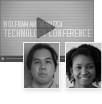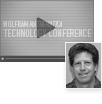GUI-Based Exporting of Customized Browser-Readable Content from Mathematica
with Phil Ramsden
Imperial College London
Mathematica is ideal for developing documents rich in mathematical content, and CDF now allows such content to be directly deployed online. It is anticipated that HTML will continue to be important, however.
The ExportAsWebPage package introduces more flexibility into converting Mathematica documents into HTML by allowing authors to set their desired formats for equations, images, animations, and multimedia content separately. This tool, first presented at the 2009 conference, has now been implemented as a GUI, and extensive online documentation has been written. It now represents a usable and flexible option for creating HTML-based content from Mathematica source documents.
Graphics may, according to preference, be exported as PNG, GIF, JPEG, or external scalable vector graphics (SVG). Equations may be exported as MathML, or as GIF images, or as embedded TeX (for rendering using a script such as MathJax or jsMath). Animations may be exported as animated GIF, or in AVI format, or as Flash. Bitmap images end up as JPEG by default, but can also be exported as PNG or GIF. Sound can be exported in WAV, AIFF, or AU formats (or, where appropriate, MIDI).
Users can now save their preferred settings, their source and destination directories, and other information (such as the URLs of style sheets and scripts) to be used in future sessions; these settings are saved to file and therefore survive quitting the kernel.
























